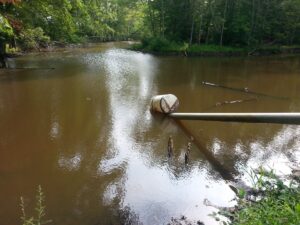FSMA Produce Safety Rule compliance, third party audit standards, and general best practices all include the need for irrigation, harvest, cleaning, sanitation, handwashing, pesticide application, drinking and postharvest water testing. Not all tests are the same, but all cost money, so make sure what your paying for meets your needs.

Here are the questions we commonly get from produce growers and answers that we hope you find helpful:
What water test do I need for a water source that is used only for irrigation of crops and/or pesticide applications?
– This water should be tested for generic E. coli, acceptable results give you a number answer of 126 CFU (colony forming units) or MPN (most probable number) or less. You do not want a presence/absence (P/A) test. A P/A test would not be sufficient for a third-party audit requirement or the FSMA PSR.
-Most water testing labs on the NJ Water Testing Lab Map (link below) offer the EPA 1603 analysis, which satisfies both the FSMA PSR anticipated requirements and third-party audit requirements.
-Other acceptable analysis methods are described on the
Produce Safety Alliance Water Analysis Method Requirement fact sheet.
-Well water sources used for irrigation should be tested once a year.
-Surface water sources should be tested at least three times during their period of use, ideally when starting irrigation, mid-season, and close to harvest. Surface water sources include irrigation ponds (spring fed, well fed, or other ponds), streams, rivers, and other bodies of water that are exposed to the surface.
-Municipal water sources used for irrigation should have a copy of the water testing record on file. These testing records are often found online or are available upon request. Made sure that generic E. coli is listed on the report.
What water test do I need for a water source that is used during the harvest process? Handwashing water? Cleaning and sanitizing use? Postharvest washing and cooling water?
-To comply with a USDA third party audit this water should be tested for the microbial standards of drinking water, showing the absence of total coliforms.
-To comply with the anticipated FSMA Produce Safety Rule you would need a non-detectable generic E. coli test result. You can use the same water test that you would use for irrigation water if the water is from the same source and if lab results show non-detectable generic E. coli. The generic E. coli test does not meet USDA third party audit requirements.
-This test should be completed once a year.
-You do not need a full drinking water test to use this water for harvest water, icing, handwashing, cleaning, sanitation, and postharvest washing and cooling.
What water test is needed for drinking water sources?
You must have a full drinking water test completed that meets the minimum standards according to NJDEP.
What do you do when you have a test result that is above the accepted threshold?
1. Switch to an alternative water source when possible
2. Inspect the water system to find potential issues causing the presence of total coliforms or generic E. coli
3. Consider water treatments to adjust the total coliforms or generic E. coli presence to an appropriate level
4. Retest the water once you’ve adjusted the system and/or treatments
Do I need to have multiple copies of my water test to satisfy third party audit standards?
Audit standards ask for proof of water test results in multiple areas, but you only need to have one copy of the water test report for each of your water sources in your food safety plan. Auditors will ask you about how water is used on the farm, the sources of that water, and will ask to see results for each of the water sources you have. If you are using surface water the auditor will want to see the results of three tests during the production season for each surface water source.
Should I have the lab pull the samples?
You are not required to have the water testing lab pull the water samples from your farm, but you may choose to. If you opt to pull the samples yourself you will want to follow the very specific instructions that the lab provides you with, including the maximum amount of time time allowed between pulling the water sample and dropping it off at the lab. Water testing labs will provide you with the water collection containers, and a chain of custody form. Make sure you get all the details on how to pull the water sample before you commit to doing so. Some general pointers:
1. Do not open the sampling bottle until you are ready to collect the water sample.
2. Water should be collected directly from the water source into the sampling bottle.
3. When collecting water from a riser or spigot the water should be run for at least one minute before collecting the water into the bottle. This allows for dirt and debris to be flushed out of the system.
4. When collecting water from a surface water source attach the bottle to a sampling pole, plunge the bottle into the water near your irrigation pump intake hose or filter, avoiding plants, bottom sediments, and algae.
5. Place the water bottle on ice and deliver to the lab within the specified amount of time, usually within 6 hours.
Need help finding a lab that can conduct the needed water tests near you? Visit our NJ Water Testing lab map for agricultural testing webpage.

